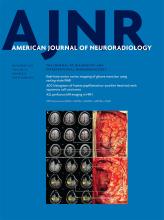Research ArticleNeurointervention
Open Access
Flow Diversion with Low-Profile Braided Stents for the Treatment of Very Small or Uncoilable Intracranial Aneurysms at or Distal to the Circle of Willis
K. Aydin, M. Barburoglu, S. Sencer, M. Berdikhojayev, B. Coskun and S. Akpek
American Journal of Neuroradiology November 2017, 38 (11) 2131-2137; DOI: https://doi.org/10.3174/ajnr.A5362
K. Aydin
aFrom the Department of Radiology (K.A., M.Barburoglu, S.S.), Neuroradiology Division, Istanbul Faculty of Medicine, Istanbul University, Capa, Istanbul, Turkey
bDepartment of Radiology (K.A.), Interventional Radiology Unit, Koç University School of Medicine, Koç University Hospital, Topkapi, Istanbul, Turkey
M. Barburoglu
aFrom the Department of Radiology (K.A., M.Barburoglu, S.S.), Neuroradiology Division, Istanbul Faculty of Medicine, Istanbul University, Capa, Istanbul, Turkey
S. Sencer
aFrom the Department of Radiology (K.A., M.Barburoglu, S.S.), Neuroradiology Division, Istanbul Faculty of Medicine, Istanbul University, Capa, Istanbul, Turkey
M. Berdikhojayev
cDepartment of Neurosurgery (M.Berdikhojayev), JSC Central Clinical Hospital, Almaty City, Kazakhstan
B. Coskun
dDepartment of Radiology (B.C., S.A.), Vehbi Koc Vakfi American Hospital, Nisantasi, Istanbul, Turkey.
S. Akpek
dDepartment of Radiology (B.C., S.A.), Vehbi Koc Vakfi American Hospital, Nisantasi, Istanbul, Turkey.

References
- 1.↵
- Aydin K,
- Arat A,
- Sencer S, et al
- 2.↵
- Brassel F,
- Grieb D,
- Meila D, et al
- 3.↵
- 4.↵
- 5.↵
- Cantón G,
- Levy DI,
- Lasheras JC
- 6.↵
- 7.↵
- Fiorella D,
- Albuquerque FC,
- Deshmukh VR, et al
- 8.↵
- 9.↵
- Zenteno MA,
- Santos-Franco JA,
- Freitas-Modenesi JM, et al
- 10.↵
- 11.↵
- Akmangit I,
- Aydin K,
- Sencer S, et al
- 12.↵
- 13.↵
- Brinjikji W,
- Lanzino G,
- Cloft HJ, et al
- 14.↵
- Nguyen TN,
- Raymond J,
- Guilbert F, et al
- 15.↵
- Cebral JR,
- Castro MA,
- Burgess JE, et al
- 16.↵
- Meng H,
- Tutino VM,
- Xiang J, et al
- 17.↵
- Meng H,
- Wang Z,
- Hoi Y, et al
- 18.↵
- Metaxa E,
- Tremmel M,
- Natarajan SK, et al
- 19.↵
- Tateshima S,
- Tanishita K,
- Hakata Y, et al
- 20.↵
- 21.↵
- Blankena R,
- Kleinloog R,
- Verweij BH, et al
- 22.↵
- 23.↵
- Makoyeva A,
- Bing F,
- Darsaut TE, et al
- 24.↵
- Cantón G,
- Levy DI,
- Lasheras JC, et al
- 25.↵
- Kim M,
- Levy EI,
- Meng H, et al
- 26.↵
- Gawlitza M,
- Januel AC,
- Tall P, et al
- 27.↵
- Pistocchi S,
- Blanc R,
- Bartolini B, et al
- 28.↵
- Kadirvel R,
- Ding YH,
- Dai D, et al
- 29.↵
- Rouchaud A,
- Ramana C,
- Brinjikji W, et al
- 30.↵
In this issue
American Journal of Neuroradiology
Vol. 38, Issue 11
1 Nov 2017
Advertisement
K. Aydin, M. Barburoglu, S. Sencer, M. Berdikhojayev, B. Coskun, S. Akpek
Flow Diversion with Low-Profile Braided Stents for the Treatment of Very Small or Uncoilable Intracranial Aneurysms at or Distal to the Circle of Willis
American Journal of Neuroradiology Nov 2017, 38 (11) 2131-2137; DOI: 10.3174/ajnr.A5362
0 Responses
Flow Diversion with Low-Profile Braided Stents for the Treatment of Very Small or Uncoilable Intracranial Aneurysms at or Distal to the Circle of Willis
K. Aydin, M. Barburoglu, S. Sencer, M. Berdikhojayev, B. Coskun, S. Akpek
American Journal of Neuroradiology Nov 2017, 38 (11) 2131-2137; DOI: 10.3174/ajnr.A5362
Jump to section
Related Articles
- No related articles found.
Cited By...
- Mass effect, aneurysms and flow diverters: Is the pipeline embolization device the Lone Virtuoso? Commentary on 'Pipeline embolization device for intracranial aneurysms presenting with mass effect: a large Chinese cohort by Zhao et al
- Safety, Efficacy, and Durability of Stent-Assisted Coiling Treatment of M2 (Insular) Segment MCA Aneurysms
- Distal anterior cerebral artery aneurysms treated with flow diversion: experience of a large-volume center and systematic review of the literature
- The safety and efficacy of using large woven stents to treat vertebrobasilar dolichoectasia
- Periprocedural safety and technical outcomes of the new Silk Vista Baby flow diverter for the treatment of intracranial aneurysms: results from a multicenter experience
- Initial and Long-Term Outcomes of Complex Bifurcation Aneurysms Treated by Y-Stent-Assisted Coiling with Low-Profile Braided Stents
- Treatment of Intracranial Aneurysms with Self-Expandable Braided Stents: A Systematic Review and Meta-Analysis
- Flow-Diversion Effect of LEO Stents: Aneurysm Occlusion and Flow Remodeling of Covered Side Branches and Perforators
- Treatment of Distal Anterior Cerebral Artery Aneurysms with Flow-Diverter Stents: A Single-Center Experience
This article has not yet been cited by articles in journals that are participating in Crossref Cited-by Linking.
More in this TOC Section
Similar Articles
Advertisement











